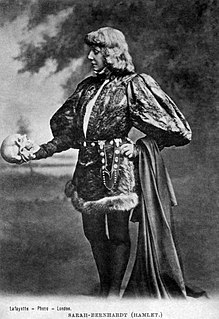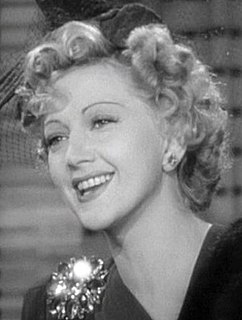Related Research Articles

Acting is an activity in which a story is told by means of its enactment by an actor or actress who adopts a character—in theatre, television, film, radio, or any other medium that makes use of the mimetic mode.
Ad hominem, short for argumentum ad hominem, refers to several types of arguments, some but not all of which are fallacious. Typically this term refers to a rhetorical strategy where the speaker attacks the character, motive, or some other attribute of the person making an argument rather than attacking the substance of the argument itself. The most common form of ad hominem is "A makes a claim x, B asserts that A holds a property that is unwelcome, and hence B concludes that argument x is wrong".

Konstantin Sergeyevich Stanislavski was a seminal Soviet and Russian theatre practitioner. He was widely recognized as an outstanding character actor and the many productions that he directed garnered him a reputation as one of the leading theatre directors of his generation. His principal fame and influence, however, rests on his 'system' of actor training, preparation, and rehearsal technique.

Method acting, known informally as the Method, is a range of training and rehearsal techniques, as formulated by a number of different theatre practitioners, that seeks to encourage sincere and expressive performances through identifying with, understanding, and experiencing a character's inner motivation and emotions. These techniques are built on Stanislavski's system, developed by the Russian actor and director Konstantin Stanislavski and captured in his books An Actor Prepares, Building a Character, and Creating a Role.

Epic theatre is a theatrical movement arising in the early to mid-20th century from the theories and practice of a number of theatre practitioners who responded to the political climate of the time through the creation of new political dramas. Epic theatre is not meant to refer to the scale or the scope of the work, but rather to the form that it takes. Epic theatre emphasizes the audience's perspective and reaction to the piece through a variety of techniques that deliberately cause them to individually engage in a different way. The purpose of epic theatre is not to encourage an audience to suspend their disbelief, but rather to force them to see their world as it is.

Stanislavski's system is a systematic approach to training actors that the Russian theatre practitioner Konstantin Stanislavski developed in the first half of the twentieth century. His system cultivates what he calls the "art of experiencing". It mobilises the actor's conscious thought and will in order to activate other, less-controllable psychological processes—such as emotional experience and subconscious behaviour—sympathetically and indirectly. In rehearsal, the actor searches for inner motives to justify action and the definition of what the character seeks to achieve at any given moment.

The Nomad Soul is an adventure game developed by Quantic Dream and published by Eidos Interactive. It was released for Microsoft Windows in 1999 and Dreamcast in 2000. The player can engage in unarmed and armed combat, explore the three-dimensional environment of Omikron City, and talk with non-player characters to progress the story. It follows an investigation into a case of serial killings, which unravels the supernatural truth behind the city's ancient history.

Stella Adler was an American actress and acting teacher. She founded the Stella Adler Studio of Acting in New York City in 1949. Later in life she taught part time in Los Angeles, with the assistance of her protégée, actress Joanne Linville, who continued to teach Adler's technique. Her grandson Tom Oppenheim now runs the school in New York City, which has produced alumni such as Marlon Brando, Robert De Niro, Harvey Keitel, Elaine Stritch, Kate Mulgrew, Kipp Hamilton, Jenny Lumet, and Jeff Celentano.
A technology demonstration, also known as demonstrator model, is a prototype, rough example or an otherwise incomplete version of a conceivable product or future system, put together as proof of concept with the primary purpose of showcasing the possible applications, feasibility, performance and method of an idea for a new technology. They can be used as demonstrations to the investors, partners, journalists or even to potential customers in order to convince them of the viability of the chosen approach, or to test them on ordinary users.

The Russian Knights is an aerobatic demonstration team of the Russian Air Force. Originally formed on April 5, 1991 at the Kubinka Air Base as a team of six Sukhoi Su-27s, the team was the first to perform outside the Soviet Union in September 1991 when they toured the United Kingdom. On December 12, 1995, disaster struck as three team jets flew in-formation into a mountainside near Cam Ranh, Vietnam during approach while en route to home from a Malaysian airshow during adverse weather conditions. The team now performs with eight Su-30SM.
In the United States, a heckler's veto is a situation in which a party who disagrees with a speaker's message is able to unilaterally trigger events that result in the speaker being silenced.

Code page 950 is the code page used on Microsoft Windows for Traditional Chinese. It is Microsoft's implementation of the de facto standard Big5 character encoding. The code page is not registered with IANA, and hence, it is not a standard to communicate information over the internet, although it is usually labelled simply as big5, including by Microsoft library functions.
Demonstration may refer to:
End-user development (EUD) or end-user programming (EUP) refers to activities and tools that allow end-users – people who are not professional software developers – to program computers. People who are not professional developers can use EUD tools to create or modify software artifacts and complex data objects without significant knowledge of a programming language. In 2005 it was estimated that by 2012 there would be more than 55 million end-user developers in the United States, compared with fewer than 3 million professional programmers. Various EUD approaches exist, and it is an active research topic within the field of computer science and human-computer interaction. Examples include natural language programming, spreadsheets, scripting languages, visual programming, trigger-action programming and programming by example.
True and False: Heresy and Common Sense for the Actor by David Mamet is an instructional book on acting, and the life and habits of the successful actor. In it, Mamet outlines his thoughts on acting, and gives advice for those practicing the craft and for aspiring practitioners.

The "art of representation" is a critical term used by the seminal Russian theatre practitioner Konstantin Stanislavski to describe a method of acting. It comes from his acting manual An Actor Prepares (1936). Stanislavski defines his own approach to acting as "experiencing the role" and contrasts it with the "art of representation". It is on the basis of this formulation that the American Method acting teacher Uta Hagen defines her recommended Stanislavskian approach as 'presentational' acting, as opposed to 'representational' acting. This use, however, directly contradicts mainstream critical use of these terms. Despite the distinction, Stanislavskian theatre, in which actors 'experience' their roles, remains 'representational' in the broader critical sense.

Museum theatre is the use of theatre and theatrical techniques by a museum for educational, informative, and entertainment purposes. It can also be used in a zoo, an aquarium, an art gallery, and at historic sites. It is generally performed by professional actors. Varieties of museum theatre include historical characters, puppetry, movement and music.

An actor or actress is a person who portrays a character in a performance. The actor performs "in the flesh" in the traditional medium of the theatre or in modern media such as film, radio, and television. The analogous Greek term is ὑποκριτής (hupokritḗs), literally "one who answers". The actor's interpretation of a role—the art of acting—pertains to the role played, whether based on a real person or fictional character. This can also be considered an "actor's role," which was called this due to scrolls being used in the theaters. Interpretation occurs even when the actor is "playing themselves", as in some forms of experimental performance art.

Presentational acting and the related representational acting are opposing ways of sustaining the actor–audience relationship. With presentational acting, the actor acknowledges the audience. With representational acting, the audience is studiously ignored and treated as voyeurs.
The Australian National Socialist Party (ANSP) was a minor Australian Neo-Nazi party that was formed in 1962. It merged into the National Socialist Party of Australia, which was originally a splinter group, in 1968.
References
- ↑ Kaatz, Elihu (2009). The End of Television?: Its Impact on the World (So Far). Indialphia: SAGE Publications. p. 25. ISBN 978-1-4129-7852-1.